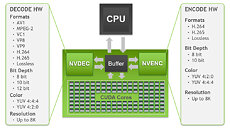
NVIDIA RTX 20-series and GTX 16-series "Turing" GPUs Get Resizable BAR Support Through NVStrapsReBAR Mod
February saw community mods bring resizable BAR support to several older platforms; and now we come across a mod that brings it to some older GPUs. The NVStrapsReBAR mod by terminatorul, which is forked out of the ReBarUEFI mod by xCurio, brings resizable BAR support to NVIDIA GeForce RTX 20-series and GTX 16-series GPUs based on the "Turing" graphics architecture. This mod is intended for power users, and can potentially brick your motherboard. NVIDIA officially implemented resizable BAR support since its RTX 30-series "Ampere" GPUs in response to AMD's Radeon RX 6000 RDNA 2 GPUs implementing the tech under the marketing name Smart Access Memory. While AMD would go on to retroactively enable the tech for even the older RX 5000 series RDNA GPUs, NVIDIA didn't do so for "Turing."
NVStrapsReBAR is a motherboard UEFI firmware mod. It modifies the way your system firmware negotiates BAR size with the GPU on boot. There are only two ways to go about modding a platform to enable resizable BAR on an unsupported platform—by modding the motherboard firmware, or the video BIOS. Signature checks by security processors in NVIDIA GPUs make the video BIOS modding route impossible for most users; thankfully motherboard firmware modding isn't as difficult. There is an extensive documentation by the author to go about using this mod. The author has tested the mod to work with "Turing" GPUs, however, it doesn't work with older NVIDIA GPUs, including "Pascal." Resizable BAR enables the CPU (software) to see video memory as a single contiguously addressable block, rather than through 256 MB apertures.
NVStrapsReBAR is a motherboard UEFI firmware mod. It modifies the way your system firmware negotiates BAR size with the GPU on boot. There are only two ways to go about modding a platform to enable resizable BAR on an unsupported platform—by modding the motherboard firmware, or the video BIOS. Signature checks by security processors in NVIDIA GPUs make the video BIOS modding route impossible for most users; thankfully motherboard firmware modding isn't as difficult. There is an extensive documentation by the author to go about using this mod. The author has tested the mod to work with "Turing" GPUs, however, it doesn't work with older NVIDIA GPUs, including "Pascal." Resizable BAR enables the CPU (software) to see video memory as a single contiguously addressable block, rather than through 256 MB apertures.

































































